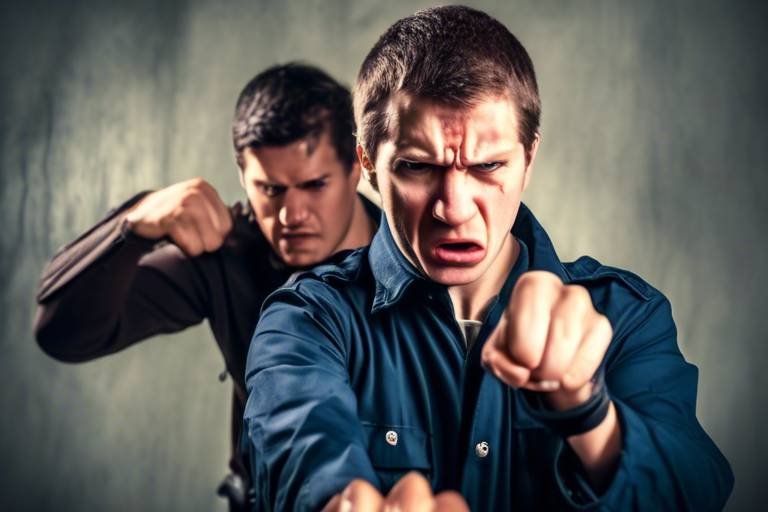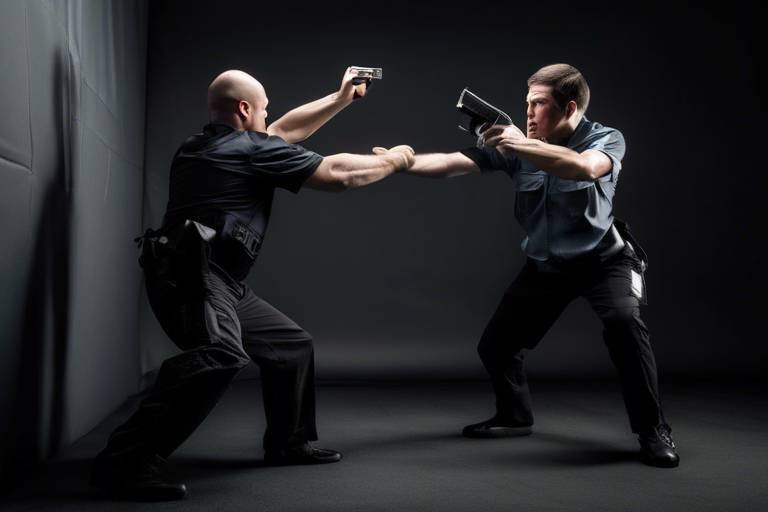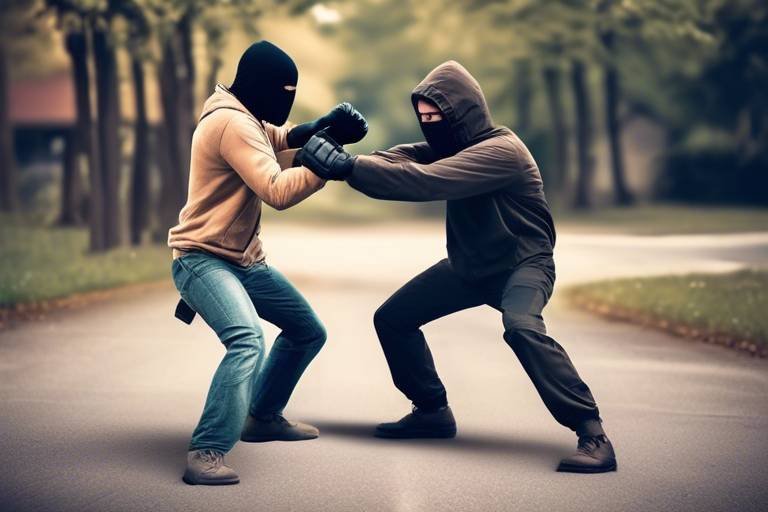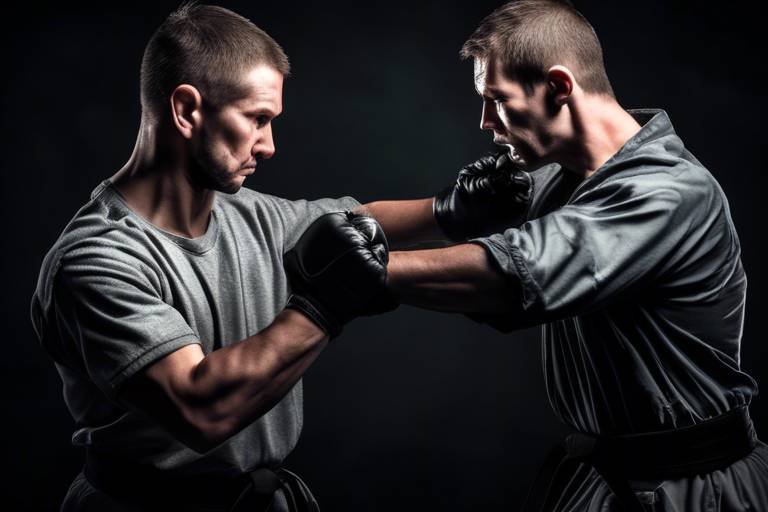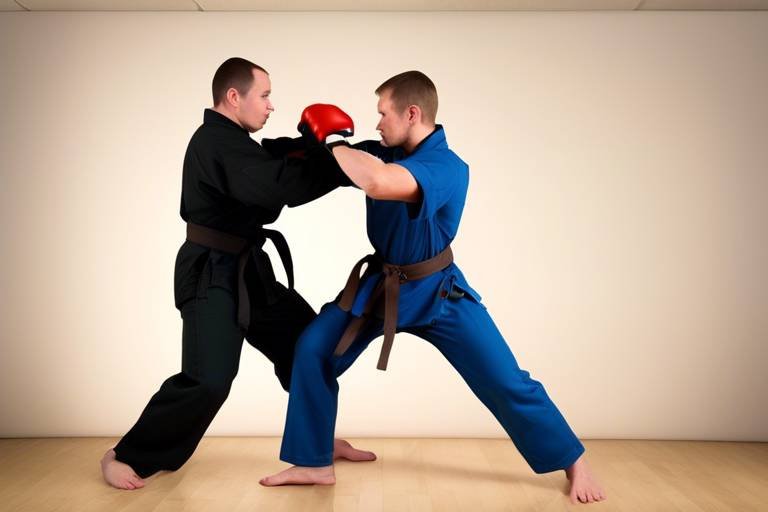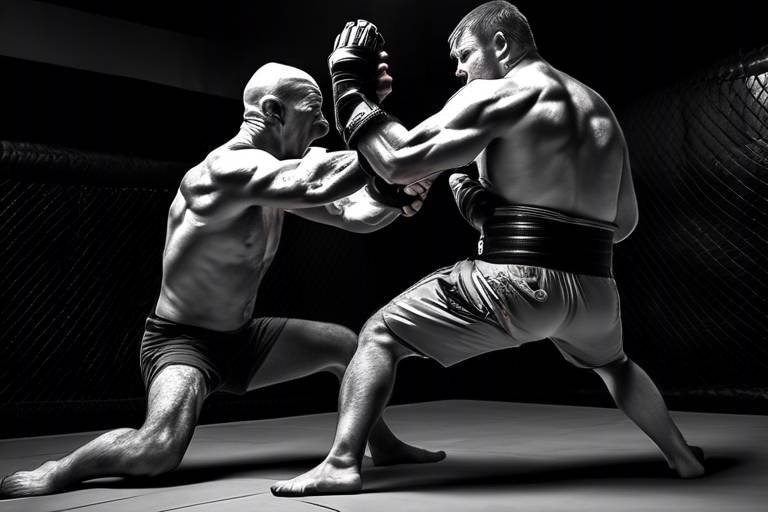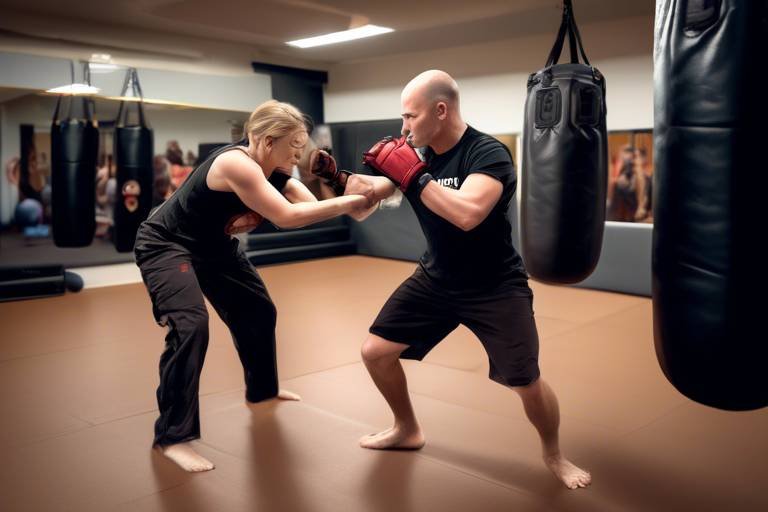Utilizing Props Available Around for Self-Defense - How to Do That?
In a world where personal safety is paramount, knowing how to utilize everyday items for self-defense can be a game changer. Imagine walking down the street and suddenly finding yourself in a precarious situation. Instead of feeling helpless, what if you could reach for something as simple as your keys, a pen, or even your bag to protect yourself? This article dives deep into the art of improvisation, showing you how to turn the ordinary into extraordinary self-defense tools. By recognizing the potential of common props available around you, you can enhance your personal safety and gain confidence in your ability to handle unexpected encounters.
First things first, let’s talk about what we mean by “common props.” These are items you likely carry with you every day but may not realize can be transformed into effective self-defense tools. Think about it: your keys, a pen, a bag, or even your smartphone can serve a purpose beyond their intended use. For instance, your keys can be held between your fingers to create a makeshift weapon, while your bag can be swung to create distance. The key here is to stay aware and think creatively. In moments of panic, it’s easy to freeze, but if you can identify and utilize what’s around you, you can turn the tide in your favor.
Now, let’s get into the nitty-gritty of improvisation. Household items are often overlooked when it comes to self-defense, but they can be incredibly effective. For example, a simple pen can be a powerful tool in your hands. It’s small, discreet, and can easily fit into your pocket or purse. In a crisis, you can use it to jab at an attacker, targeting sensitive areas of the body. But that’s just the tip of the iceberg. Your bag can also serve multiple purposes, from creating distance to acting as a shield. The beauty of these items is that they’re always within reach, making them ideal for self-defense.
Let’s break down the use of a pen as a self-defense weapon. You might be surprised to learn that a pen can be more than just a writing tool. When held correctly, it can deliver a quick jab or strike to an assailant. The trick is to grip it firmly, using your thumb and forefinger to create a stable hold. Aim for vulnerable areas such as the eyes, throat, or groin, as these targets can incapacitate an attacker long enough for you to escape. Remember, the goal isn’t to engage in a prolonged fight; it’s to create an opportunity for you to get away safely.
Understanding the human body’s vulnerable areas is crucial for effective self-defense. Here’s a quick rundown of targets you should focus on:
- Eyes: A sharp jab can blind or distract an attacker.
- Throat: A quick strike can cause significant pain and disrupt breathing.
- Groin: A well-placed hit can incapacitate an assailant.
By aiming for these sensitive spots, you increase your chances of escaping a dangerous situation.
In a self-defense scenario, speed is of the essence. Here are some quick techniques to keep in mind:
- Hold the pen tightly and aim for the attacker's eyes or throat.
- Use your body weight to add force to your jab.
- If possible, create distance before striking.
Practicing these techniques can help you react swiftly and effectively when it matters most.
Your bag is another versatile tool that can be used creatively in self-defense. Whether it’s a backpack, purse, or tote, it can serve multiple functions. For instance, you can swing your bag to create distance between you and an attacker, giving you time to escape. Additionally, if you need to shield yourself from blows, your bag can act as a barrier. The key is to remain calm and think on your feet. Your bag isn’t just a carrier of your belongings; it can be a crucial part of your self-defense strategy.
Believe it or not, your clothing can also play a vital role in self-defense. Items like belts and jackets can be transformed into effective tools. A belt, for example, can be used to strike or even restrain an attacker. It’s sturdy and can deliver a surprising amount of force when swung correctly. On the other hand, your jacket can act as a shield, protecting you from blows while also giving you the opportunity to distract or confuse an assailant.
When it comes to using a belt, the possibilities are endless. You can swing it to strike an attacker or use it to restrain them if the situation allows. The key is to remain focused and deliver your strikes with precision. The strength of a belt lies in its ability to surprise an opponent, so don’t underestimate its potential. Just like a whip, a well-timed swing can catch an attacker off guard and give you the upper hand.
Your jacket can serve as a protective barrier against blows. By holding it up, you can deflect strikes while also using it to create confusion. For example, if you throw your jacket at an attacker, it can momentarily blind them, giving you the chance to escape. This tactic not only protects you but also allows you to use your surroundings creatively. Remember, self-defense is about using whatever you have at your disposal to stay safe.
Q: Can everyday items really be effective for self-defense?
A: Absolutely! Everyday items can be surprisingly effective when used with intention and awareness.
Q: What should I prioritize when choosing a self-defense tool?
A: Look for items that are easy to carry, discreet, and can be used quickly in an emergency.
Q: How can I practice these techniques safely?
A: Consider enrolling in a self-defense class or practicing with a trusted friend to ensure you’re ready if the need arises.

Identifying Common Props
When it comes to self-defense, you might be surprised by the variety of everyday items that can be transformed into effective tools for protection. The key is to recognize the potential in what you have around you. Think about it: your surroundings are filled with objects that, with a little creativity, can serve as your first line of defense in an unexpected situation. From the simple act of holding your keys in a certain way to using a bag strategically, being aware of these items can make a significant difference.
Let’s start with something as simple as your keys. They are not only essential for accessing your home or car, but when held between your fingers, they can provide a surprising level of protection. Imagine holding your keys tightly, with one protruding out; in a pinch, this can act as a makeshift weapon. The same goes for your bag. Whether it’s a backpack or a purse, it can be used to create distance between you and an aggressor, or even as a shield to deflect blows. Just think of it as an extension of your body—something you can maneuver to protect yourself.
Other common props include items like umbrellas and water bottles. An umbrella can be wielded to poke or jab, while a water bottle can be thrown to distract or deter an attacker. The versatility of these items means that you don’t have to be a martial arts expert to defend yourself; you just need to be aware of how to use what you have on hand.
To help visualize this, here’s a quick table of some common props and their potential self-defense uses:
| Item | Potential Use |
|---|---|
| Keys | Can be used for jabbing or scratching |
| Bag | Can create distance or shield |
| Umbrella | Can be used to poke or block |
| Water Bottle | Can be thrown or used to strike |
By recognizing these common props and their potential, you empower yourself to react swiftly and effectively in situations where your safety is at risk. It’s all about being resourceful and thinking on your feet. Remember, self-defense is not just about physical strength; it’s about using your environment to your advantage. So next time you step out, take a moment to assess your surroundings and consider how you might utilize everyday items for your protection.

Improvising with Household Items
When it comes to self-defense, the notion of being prepared often conjures images of martial arts training or specialized weapons. However, the reality is that many of us have effective self-defense tools right in our homes! Everyday household items can be transformed into powerful allies in a pinch. Imagine being in a situation where you need to defend yourself, and instead of panicking, you reach for something as simple as a kitchen utensil or a piece of furniture. Let’s explore some common household items that can easily be used for self-defense.
One of the most versatile items in your home is the kitchen knife. While it’s primarily a tool for cooking, in a self-defense scenario, it can serve as a formidable weapon. The key here is to understand how to grip it securely and aim for vulnerable areas of an attacker. Remember, it’s not about being a trained chef; it’s about using what you have to protect yourself. Similarly, a rolling pin can be wielded as a striking tool. Its weight and shape make it perfect for creating distance between you and an aggressor.
Another household item that might not immediately come to mind is a chair. If you find yourself cornered, using a chair can provide a substantial barrier. You can hold it in front of you to block incoming strikes or use it to push an attacker away. The principle here is simple: create space and give yourself time to escape. Additionally, if you have a flashlight handy, it can serve a dual purpose. Not only can it illuminate dark areas, but it can also be used to strike or distract an attacker with its bright beam.
Let’s not forget about your clothing. Items like scarves or ties can be used to restrain an attacker or even to create a distraction. The versatility of fabric means that you can adapt its use depending on the situation. For example, a scarf can be thrown over an attacker’s head to momentarily blind them, giving you a chance to escape. In a similar vein, a sturdy backpack can serve as a shield. By holding it up, you can protect yourself from blows while simultaneously creating a barrier that can help you make a quick getaway.
In essence, the key to improvising with household items lies in your creativity and quick thinking. The next time you’re in a situation where you feel vulnerable, remember that you don’t need to be armed with a weapon to defend yourself. Instead, look around and consider how you can use what’s available to you. It’s all about being resourceful and adapting to your environment. By thinking outside the box, you can turn even the most mundane objects into effective self-defense tools.
- What household items can I use for self-defense? Almost anything can be used, but common items include kitchen knives, rolling pins, chairs, flashlights, and your clothing.
- How do I safely use a kitchen knife for self-defense? Grip the knife firmly, aim for vulnerable areas, and remember that your safety is the priority. Only use it if absolutely necessary.
- Can I use furniture for self-defense? Yes! A chair can be an effective barrier, and you can use it to create distance from an attacker.
- Is it legal to use household items for self-defense? Laws vary by location, so it's essential to understand your local laws regarding self-defense.

Using a Pen as a Weapon
When you think of self-defense, a pen might not be the first thing that comes to mind, but you'd be surprised at how effective this everyday item can be in a pinch. Imagine you're in a crowded café, and suddenly you feel threatened. You glance around, and there it is: your trusty pen, sitting innocently on the table. This small yet mighty tool can be a game changer. It’s lightweight, easy to carry, and can be wielded with surprising force. The key is knowing how to use it effectively.
First, let's talk about how to grip the pen for maximum impact. Hold it firmly in your hand, ensuring that your fingers wrap around it securely. You want to create a fist-like grip that allows you to use it both as a striking tool and a jabbing weapon. The pen’s pointed end can be directed towards vulnerable areas of an attacker’s body, such as the eyes, throat, or soft spots under the ribs. Remember, the goal is to create an opportunity to escape, not to engage in a prolonged fight.
Now, you might be wondering which techniques are best to employ. Here’s a quick rundown:
- Jabbing: Use the pointed end to jab at an attacker’s eyes or throat. A quick, sharp motion can cause temporary disorientation.
- Striking: If the situation allows, you can strike with the pen against sensitive areas, generating pain and giving you a chance to flee.
- Deflecting: If an attacker comes at you, use the pen to deflect their hand or an incoming strike, creating space to escape.
It's essential to practice these techniques in a safe environment, perhaps with a friend or instructor, to build confidence. Remember, the more you practice, the more instinctive your reactions will become. In a high-stress situation, your body will rely on muscle memory, so honing these skills is crucial.
Additionally, understanding the anatomy of your attacker can significantly enhance the effectiveness of your defense. Targeting vulnerable areas can make a substantial difference. Here’s a quick reference table:
| Vulnerable Area | Effect of Strike |
|---|---|
| Eyes | Temporary blindness, disorientation |
| Throat | Difficulty breathing, pain |
| Solar Plexus | Pain, wind knocked out |
| Groin | Severe pain, incapacitation |
In conclusion, a pen can be a surprisingly effective self-defense weapon if you know how to use it. Its accessibility makes it a perfect choice for anyone looking to enhance their personal safety. Always be aware of your surroundings, stay alert, and remember that the best defense is to avoid confrontation whenever possible. However, if you find yourself in a threatening situation, don’t underestimate the power of that little pen in your pocket!

Targeting Vulnerable Areas
When it comes to self-defense, knowing where to strike can make all the difference. The human body has several vulnerable areas that, when targeted, can incapacitate an attacker and give you the crucial seconds you need to escape. Imagine standing in a crowded room, and suddenly, you're confronted by someone with ill intentions. In that moment, your awareness of these sensitive spots can transform an everyday item into a powerful tool for protection.
Some of the most effective vulnerable areas to target include:
- Eyes: A quick jab or poke can temporarily blind your assailant, giving you a chance to flee.
- Nose: A forceful strike can cause significant pain and disorientation.
- Throat: A swift blow can disrupt breathing and incapacitate an attacker.
- Solar Plexus: A well-placed strike here can knock the wind out of someone, making it hard for them to continue their advance.
- Knees: Targeting the knees can destabilize an attacker, causing them to fall or lose balance.
Understanding these points is not just about physical strength; it’s about using your environment to your advantage. For example, if you're armed with a simple pen, a well-aimed jab to the eye or throat can be devastating. Similarly, if you're holding a bag, using it to shield yourself while delivering a quick strike to the solar plexus can create a moment of confusion, allowing you to escape.
Moreover, it's essential to practice these techniques in a safe environment. Role-playing scenarios with a friend can help you build muscle memory, making it easier to react instinctively when faced with danger. Remember, the goal of self-defense is not to engage in a prolonged confrontation but to create an opportunity to escape safely.
By familiarizing yourself with these vulnerable areas and practicing your techniques, you can significantly enhance your self-defense skills. The more you prepare, the more confident you'll feel in your ability to protect yourself when it matters most.
Q1: What should I do if I can't remember the vulnerable areas during an attack?
A1: In high-stress situations, it's normal to forget details. Focus on delivering any strike you can to create distance and escape. The key is to act quickly and decisively.
Q2: Are there any legal implications to using everyday items for self-defense?
A2: Laws regarding self-defense vary by location. It's essential to familiarize yourself with local laws to understand what is permissible in a self-defense situation.
Q3: Can self-defense techniques be learned online?
A3: While online resources can provide valuable information, practical training with a qualified instructor is recommended to ensure proper technique and safety.
Q4: How can I stay calm during a self-defense situation?
A4: Practice mindfulness and breathing techniques regularly. The more you prepare mentally, the easier it will be to stay calm and focused in a real situation.

Quick Defense Techniques
When it comes to self-defense, the key is to be prepared and to act quickly. In unexpected situations, having a few in your arsenal can make all the difference. Let's dive into some effective methods you can use with a simple pen or similar everyday objects. Remember, the goal is to create an opportunity for escape, not to engage in a prolonged confrontation.
First off, let's talk about grip. How you hold your pen can significantly impact your effectiveness. Grip it firmly, almost like you’re holding a dagger. This allows you to use it as a striking tool. Aim for vulnerable areas of your assailant's body, such as the eyes, throat, or groin. A well-placed jab can incapacitate an attacker long enough for you to flee. It’s essential to practice this grip; think of it as holding onto a lifeline during a storm.
Now, let’s get into some quick moves you can practice. One effective technique is the jab and twist method. Here’s how it works: jab the pen toward the attacker's face or throat, then twist it as you pull back. This not only causes pain but also creates a moment of confusion, giving you the precious seconds you need to escape. You can visualize it as a quick dance move—sharp, sudden, and with a clear exit strategy.
Another technique is the defensive block. If an attacker is coming at you, you can use the pen to block their strikes. Hold it horizontally in front of you to deflect blows. This creates a barrier and gives you a chance to counterattack. Think of it as using a shield in battle—your pen becomes an extension of your arm, protecting you from harm.
In addition to these techniques, remember that your body is also a powerful tool. Use your knees to strike upwards while you jab with the pen. This combination can catch an attacker off guard, making them rethink their approach. It’s about using whatever you have at your disposal, much like a chef improvising in the kitchen with whatever ingredients are on hand.
Lastly, practice makes perfect. Try these techniques in front of a mirror or with a trusted friend. The more you practice, the more instinctive these moves will become. Before you know it, you’ll feel more confident and ready to defend yourself in any situation. Think of it as preparing for a big game; you wouldn’t go in without rehearsing your plays, right?
- Can a pen really be effective for self-defense? Yes, a pen can be a surprisingly effective tool for self-defense. Its compact size allows for easy concealment, and with the right techniques, it can target vulnerable areas of an attacker.
- What other everyday items can I use for self-defense? Items like keys, bags, and even clothing can be utilized creatively for self-defense. The key is to recognize their potential in a crisis.
- How can I practice these techniques safely? It's best to practice in a safe environment, like at home or with a friend. Consider enrolling in a self-defense class to learn more techniques and gain confidence.

Employing a Bag for Defense
When it comes to self-defense, your bag can be more than just a carrier for your belongings; it can be a versatile tool for protection. Imagine walking down the street and suddenly feeling threatened. Instead of panicking, you can quickly think of your bag as a means to create distance or shield yourself from an attacker. The beauty of using a bag lies in its accessibility and the various ways you can employ it in a crisis.
First off, consider the type of bag you carry. A backpack, tote, or even a handbag can serve different purposes in self-defense. For instance, a sturdy backpack can be swung to create distance between you and an assailant, while a smaller handbag can be used to block blows. The key is to be aware of your surroundings and ready to act. Here are some practical techniques you can use:
- Creating Distance: If you find yourself in a threatening situation, use your bag to push the attacker away. A swift motion of swinging your bag can create a barrier that gives you precious seconds to escape.
- Shielding Yourself: Hold your bag in front of you to absorb any incoming blows. This can protect vital areas of your body while also giving you a moment to assess your next move.
- Distraction: Throwing your bag at the attacker can serve as a distraction. This unexpected action can give you the upper hand to flee or counterattack.
Additionally, it’s important to consider what’s inside your bag. Having items that can be used in self-defense, like a water bottle or even a laptop, can enhance your ability to protect yourself. Just think of your bag as a mini arsenal—the more prepared you are, the better your chances of defending yourself effectively. Remember, the goal is to escape safely, not to engage in a prolonged confrontation.
In conclusion, your bag is not just for carrying your essentials; it can be a powerful ally in self-defense. By being mindful of how to use it and what you carry, you can turn an everyday item into a critical tool for personal safety. So the next time you leave the house, take a moment to think about how your bag can help you in an unexpected situation. It's all about being prepared and knowing how to use what you have at your disposal.
Here are some common questions regarding the use of everyday items for self-defense:
- Can any bag be used for self-defense? Yes, any bag can be used, but sturdier bags like backpacks or those with a solid structure are more effective.
- What should I keep in my bag for self-defense? Consider items like a water bottle, a flashlight, or any other hard objects that can be used to strike or block.
- Is it legal to use a bag for self-defense? Generally, using any object for self-defense is legal as long as it is proportional to the threat. Always check local laws for specifics.

Utilizing Clothing as a Defense Tool
When it comes to self-defense, many people overlook the potential of their clothing. You might not realize it, but your everyday attire can be a powerful ally in a dangerous situation. Think of your clothes as an extension of your personal safety arsenal. They’re not just fabric; they can be transformed into tools that help you defend yourself. Whether it’s a sturdy belt or a heavy jacket, your clothing can serve multiple purposes in an emergency. Let’s dive into some practical ways to utilize your clothing effectively when faced with a threat.
First up, let’s talk about the trusty belt. A belt is more than just a fashion accessory; it can be an effective tool for self-defense. Imagine you’re in a tight spot, and you need to create some distance between you and an attacker. A belt can be used to strike or even to restrain someone. The key is to grip it firmly and use the buckle or the end to deliver a swift blow to vulnerable areas like the face or body. It’s all about using your surroundings to your advantage. You can even use the belt to swing and distract an attacker, giving you precious seconds to escape.
Next, consider your jacket. This seemingly ordinary piece of clothing can be a game-changer. In a confrontational scenario, your jacket can act as a shield against blows. If someone is coming at you, quickly wrapping your jacket around your arm can help absorb the impact, protecting you from injury. Furthermore, you can use your jacket to create a diversion. Throwing it over an attacker’s head can disorient them, providing you with a crucial opportunity to escape. It’s like throwing a smoke bomb but without the smoke! The element of surprise is your best friend in self-defense.
Additionally, think about the material of your clothing. Heavier fabrics can provide more protection, while lighter materials can be utilized for quick movements. For instance, if you’re wearing a denim jacket, it can help shield you from an attacker’s grasp due to its sturdiness. On the other hand, a loose-fitting shirt can be used to your advantage by allowing you to slip out of an attacker’s hold. The versatility of clothing is something you should definitely keep in mind when planning your self-defense strategies.
To summarize, your clothing can be a valuable asset in self-defense. Here’s a quick recap of how you can utilize your clothes:
- Belt: Use it to strike or restrain an attacker.
- Jacket: Employ it as a shield or distraction tool.
- Fabric Choice: Opt for heavier materials for protection and lighter ones for agility.
Remember, the goal of self-defense is not just to fight back, but to create an opportunity for escape. Every little bit helps, and being aware of how to use your clothing effectively can make a significant difference in a threatening situation. So, the next time you get dressed, think about how your outfit can double as a self-defense tool. It’s all about being prepared and knowing how to turn the ordinary into the extraordinary!
Q: Can I really use my clothing for self-defense?
A: Absolutely! Your clothing can serve multiple purposes, such as acting as a shield or a striking tool. Items like belts and jackets can be particularly useful in a pinch.
Q: What type of clothing is best for self-defense?
A: Heavier fabrics like denim or leather provide more protection, while lighter materials can help you move quickly. Consider your environment and dress accordingly.
Q: Is it safe to rely on clothing for self-defense?
A: While clothing can assist in self-defense, it’s important to remember that the best defense is avoidance. Always prioritize your safety and escape whenever possible.

Using a Belt for Defense
When it comes to self-defense, one of the most underrated items you carry daily is your belt. Yes, that simple accessory that holds your pants up can also serve as a powerful tool for protection. Imagine being in a situation where you feel threatened; your belt can transform from a mere fashion statement into a defensive weapon. But how exactly can you use it? Let’s dive into some practical techniques!
First off, a belt can be used for striking. If you find yourself in a confrontation, you can swing your belt like a whip. The buckle acts as a hard surface that can deliver a painful blow to an attacker. Aim for sensitive areas such as the face or stomach. The surprise element of using a belt is what makes it effective; attackers often don't expect to be hit with something so ordinary!
Additionally, a belt can be employed for restraint. If you need to control an assailant, you can use your belt to tie their hands or feet. This technique requires a quick mind and some practice, but it can be incredibly effective in a pinch. Just loop the belt around their wrists and pull tight. This can buy you precious seconds to escape or call for help. Remember, the key is to act swiftly and decisively.
In a more defensive scenario, you can use your belt to create distance between you and your attacker. By holding one end of the belt and swinging it outward, you can keep an assailant at bay. This technique can help you maintain a safe distance while you look for an opportunity to escape. The longer you can keep them away, the better your chances of getting to safety.
Now, let’s talk about some quick tips for using a belt effectively in self-defense:
- Choose the Right Belt: A sturdy, wide belt is preferable as it provides more striking power.
- Practice Your Techniques: Familiarize yourself with how to swing and restrain using your belt.
- Stay Calm: In a stressful situation, staying calm can help you think clearly and react effectively.
In summary, your belt is more than just an accessory; it can be a vital part of your self-defense strategy. By understanding how to use it for striking, restraining, and creating distance, you can enhance your personal safety. So next time you put on your belt, remember that it could be your first line of defense in an unexpected situation. Stay safe and be prepared!
Q: Can any belt be used for self-defense?
A: While any belt can be used, a wider and sturdier belt tends to be more effective for striking and restraint.
Q: Is it legal to use a belt for self-defense?
A: Laws vary by location, but self-defense is generally permissible as long as the force used is proportional to the threat.
Q: How can I practice using my belt for self-defense?
A: You can practice techniques at home, using a pillow or a dummy to simulate an attacker, ensuring you’re prepared if the need arises.

Jacket as a Shield
When it comes to self-defense, your jacket can be more than just a fashion statement; it can serve as a valuable shield in a dangerous situation. Imagine you're out and about, and suddenly you find yourself facing an aggressive individual. Your instinct might be to run, but what if you can't? This is where your jacket comes into play. It's a readily available tool that can provide you with an extra layer of protection and a chance to escape.
First, think about how to use your jacket effectively. You can wrap it around your arm to create a barrier between you and an attacker. This simple action can absorb some impact from punches or grabs, giving you precious seconds to assess the situation. Alternatively, if you're caught off guard, you can quickly throw your jacket over the attacker's head. This tactic can momentarily blind them, allowing you to make a swift getaway. It’s like throwing a curveball in baseball; it disrupts their focus and gives you the advantage.
In addition to its defensive capabilities, your jacket can also be used to distract or confuse an attacker. For instance, if you can whip it off and toss it in their direction, it might cause them to pause, giving you the opportunity to escape. Think of it as a magician's trick—distracting the audience while you prepare your next move.
Moreover, the material of your jacket can play a significant role in its effectiveness as a shield. A heavy-duty jacket, like a leather or a thick winter coat, can provide more protection than a lightweight windbreaker. In a pinch, it’s important to consider what you’re wearing. If you find yourself in a precarious situation, your jacket can act as a makeshift armor, absorbing some of the blows.
To summarize, your jacket can be an unexpected ally in self-defense. Here are a few techniques to remember:
- Wrap it around your arm for added protection.
- Throw it over the attacker's head to blind and confuse them.
- Use it to distract by tossing it in their direction.
- Consider the material for optimal protection.
Remember, the goal of using your jacket as a shield is not to engage in a fight but to create an opportunity for escape. Self-defense is about survival, and knowing how to use what you have on hand can make all the difference in a critical moment. So the next time you put on your jacket, consider it not just a piece of clothing but a potential lifesaver.
Q: Can any jacket be used for self-defense?
A: While any jacket can be used, heavier materials like leather or thick winter coats offer better protection and can absorb more impact.
Q: Is it safe to rely on a jacket for self-defense?
A: While a jacket can provide a temporary advantage, it's essential to remember that the best self-defense strategy is to avoid confrontation whenever possible.
Q: What other clothing items can be used for self-defense?
A: Belts, scarves, and even shoes can be used creatively in self-defense situations, depending on the context.
Frequently Asked Questions
- Can I really use everyday items for self-defense?
Absolutely! Many common items like keys, pens, and bags can be effectively used for self-defense. The key is to stay aware of your surroundings and know how to utilize these items when needed.
- What are some effective techniques for using a pen as a weapon?
When using a pen, grip it firmly and aim for vulnerable areas such as the eyes or throat. Quick jabbing motions can create an opportunity for escape. Remember, it’s not just about strength; it’s about precision!
- How can I use my bag for self-defense?
Your bag can be a great tool! You can swing it to create distance or use it as a shield. If you have items in your bag, they can also add weight and force to your swings, making it even more effective.
- What clothing items can help in self-defense?
Believe it or not, your clothing can be a lifesaver! Items like belts can be used to strike or restrain, while jackets can serve as a shield against blows. Get creative with what you have on!
- Is it safe to improvise with household items for self-defense?
Yes, improvising with household items can be safe if done correctly. Just ensure you understand how to use the items effectively and be mindful of your surroundings. Always prioritize your safety!
- What should I do if I feel threatened?
If you feel threatened, trust your instincts. Look for an opportunity to escape, and if you have to defend yourself, remember the techniques you’ve learned. Stay calm and focused!
- Can self-defense techniques be learned easily?
Many self-defense techniques can be learned quickly with practice. The more familiar you are with using everyday items, the more confident you’ll feel in a crisis. It’s all about preparation!



